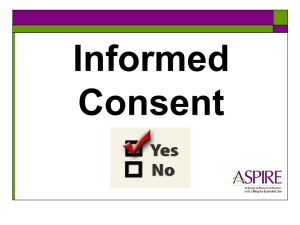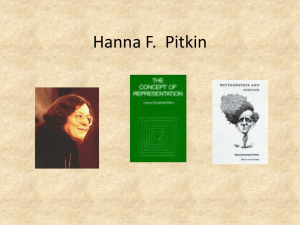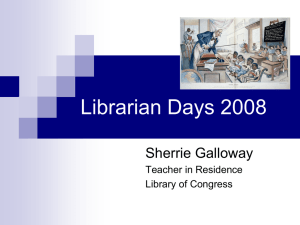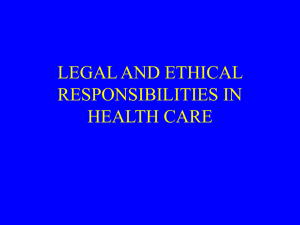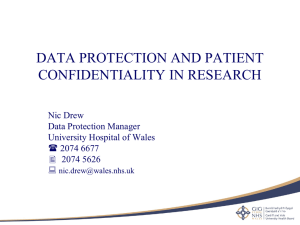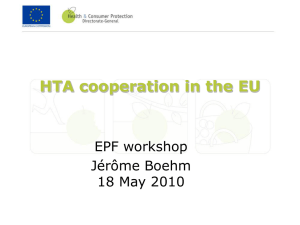Human tissue: the matter of life and death
advertisement
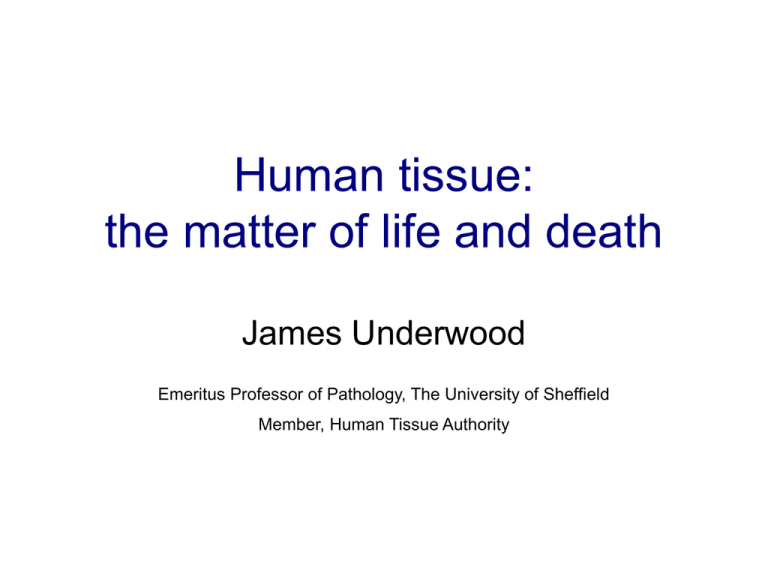
Human tissue: the matter of life and death James Underwood Emeritus Professor of Pathology, The University of Sheffield Member, Human Tissue Authority Properties of human tissue Diagnostic material Anatomical, physiological and biochemical features Resource for education, training and research Symbolic and cultural significance Religious and secular beliefs Emotional associations “… you took hair you had cut from Mr Armstrong’s head and, without requesting permission from or even advising Mr Armstrong, sold that hair to Mr Mueller…” Neil Armstrong Research on tissue from the living Usually surplus tissue from diagnosis or treatment Anonymized tissue often sufficient Identification of new treatments Breast carcinoma: HER2 amplification and selection for Herceptin treatment Individualized cancer therapies The Moore case John Moore diagnosed with hairy cell leukaemia (1976) Splenectomy sampled for research Cell lines patented (1984) Moore sues University of California Case settled (1990): ‘fiduciary duty’ to inform Moore of financial interest in his tissues Research on autopsy tissue Hypertrophic obstructive cardiomyopathy Variant CJD Human tissue law • Murder Act 1752 – Corpses of executed murderers could be used for dissection The Reward of Cruelty (William Hogarth) Human tissue law • Murder Act 1752 • Anatomy Act 1832 – Lawful to use unclaimed corpses – Consented donation – Licensed anatomists The Resurrectionists (Thomas Rowlandson) Human tissue law • Murder Act 1752 • Anatomy Act 1832 • Human Tissue Act 1961 – Lawful to use tissue after death for treatment, education or research if no relative objects Limb transplantation by Saints Cosmas and Damian Human tissue law • • • • Murder Act 1752 Anatomy Act 1832 Human Tissue Act 1961 Human Tissue Act 2004 – The living and the dead – The “golden thread” of consent – Regulation by licensing Human tissue law • • • • • Murder Act 1752 Anatomy Act 1832 Human Tissue Act 1961 Human Tissue Act 2004 Coroners (Amendment) Rules 2005 – Coroner must inform relatives about retention – Relatives choose to donate or discard Genetic analysis Consultation by Human Genetics Commission (2000) Recommended that nonconsensual DNA analysis should be criminalised Human Tissue (Scotland) Act 2006 Human Tissue Act 2004 Human Tissue Act 2004 • Anything from a living or dead body and containing human cells is “relevant material”: • • • • tissue biopsies whole organs blood urine, saliva, faeces, etc Nails, hair and gametes excepted Human Tissue Authority issues licences Consent required for “scheduled purposes” Penalties for offences (e.g. 3 years in prison) Schedule 1 of HT Act 2004 Consent always required Anatomy Post mortem Information relevant to another person Transplantation Public display Research* Consent required only if material is from the dead Clinical audit Education and training Public health monitoring Quality assurance *Unless from a living individual, anonymised and REC (NRES) approved Consent: the “golden thread” in the HT Act 2004 Except for anatomy and public display, consent is not defined in the Act Consent is elaborated in HTA’s code of practice Consent is a process, not a signature on a form Consent and licences for tissue research The material Donor Purpose Living Storage only for ethicallyapproved project Dead The law Anonymised Consent Licence No Yes No Yes No No Storage for unspecified research No Yes Yes Yes No Yes Any material n/a Yes Yes Consent and licences for tissue research The material Donor Purpose Living Storage only for ethicallyapproved project Dead The law Anonymised Consent Licence No Yes No Yes No No Storage for unspecified research No Yes Yes Yes No Yes Any material n/a Yes Yes Research idea Ethics committee Research project Better treatment The burden of regulatory ethics Re-apply? Research idea Ethics committee Think again Better treatment Ethical (NRES) approval of research using banked or archived tissue REC approval of the tissue bank: Tissue from diagnostic archives: Bank must have HTA licence Diagnostic archives cannot be HTA licensed Automatic approval of all projects conforming to set criteria REC approval required for each project Public support for research 220 post-operative patients in Sheffield 96.3% do not object to use of their tissue for research From Bryant RJ, et al. J Clin Pathol 2008;61:322–326 Most frequent objection is to use for transplantation www.hta.gov.uk


